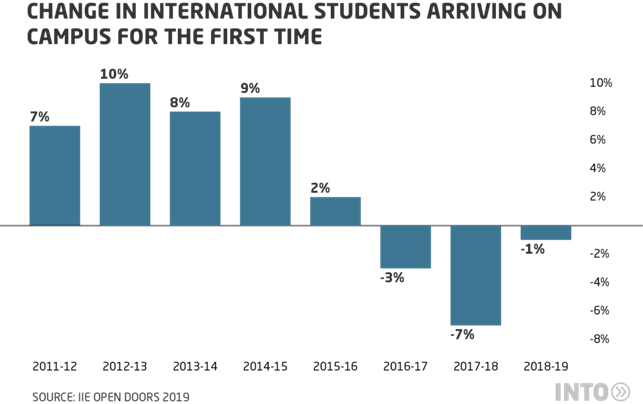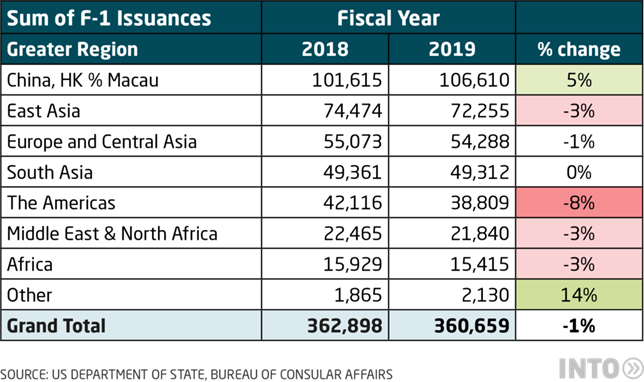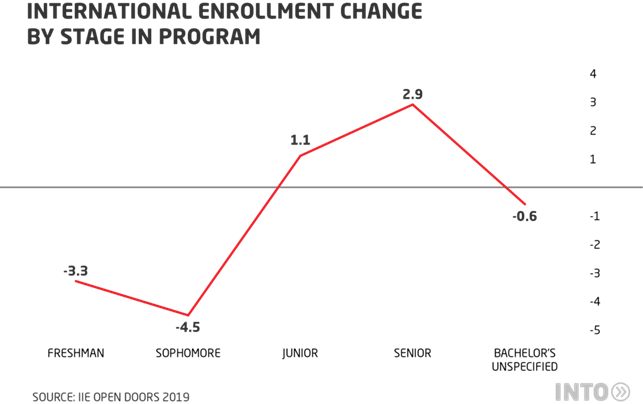Open Doors Report 2019: Things can only get better

To kick off International Education Week this past Monday, the Institute of International Education (IIE) released its 70th Open Doors Report outlining international student mobility trends in the United States during the 2018/19 academic year. Assistant Secretary of State for Educational and Cultural Affairs Marie Royce commenced the release by lauding the nation’s status as the most popular study destination for international students, attracting more than one million international students for the fourth year in a row.
The report also indicated that there was a decrease in the 6.6 percent declines in new international student enrollments (NSEs) in 2017/18 to 0.9 percent in 2018/19, evidence that suggests the two-year drop in international enrollments has stabilized.
Stabilization or distortion: Understanding the real picture
As identified in a blog post earlier this year, the incorporation of certain data into the U.S. Department of Homeland Security’s release of quarterly SEVIS data in March resulted in a distorted snapshot of the international enrollment environment. It is no different with the Open Doors Report.
As part of its calculations, IIE includes in Open Doors international students completing optional practical training (OPT)—an opportunity whereby they may stay in the U.S. for up to three years upon completion of their studies to gain work experience in their fields. Although these students are not enrolled in colleges or universities, they account for 20% of the total numbers reported in Open Doors and for almost 40 percent of the total Indian student population in the U.S.
Removing the 9.5% growth in the population of international students completing OPT from the equation, there has been a two percent decline in the number of enrolled international students in the U.S.—rather than the 0.05 percent increase in the total number of international students reported in Open Doors.
Certainly, this revelation makes for a bleak picture. However, distortion aside, the real issue is whether declines in previous years will be countered by NSE growth in years to come.
A light at the end of the tunnel?
As part of the Open Doors release, IIE surveyed 500 colleges and universities across the nation to gain insight into their fall 2019 enrollments. The Snapshot Survey indicates the decline in NSEs has levelled off from -7 percent in 2017/18 to -1 percent in 2018/19, respectively. This survey, however, is a snapshot of the past composed only of feedback and data from the 2018/19 academic year—nothing more recent than that.

It is therefore useful to benchmark this snapshot against more up-to-date F-1 (student) visa statistics from the U.S. Department of State’s Bureau of Consular Affairs. This data, updated in October 2019, confirms that the decline in international enrollments is stabilizing. Of interest is the fact that there has been a five percent increase in the number of visas issued to Chinese students in 2019, despite the ongoing trade war between the U.S. and China.
Of greater concern, however, might be the drop in the number of visas issued to international students from the Americas. This is largely driven by a dip in the number of visas issued to Brazilian students on short-term programs and the fact that fewer Venezuelan students travel overseas for their education.

Digesting previous declines: The challenge of trailing indicators
Although the dip in NSEs appears to be stabilizing, the steeper decline of new students reported in Open Doors for 2017/18 is now working its way through the system. The 6.6 percent decline in NSEs reported in 2017/18 is now visible in the 4.5 percent decline in the number of international undergraduate students in their sophomore year, reported in 2018/19. Inevitably, this will dampen international enrollment numbers at the junior and senior levels in next year’s Open Doors Report. However, the Report will hopefully reveal continued recovery in the number of NSEs.

What lies ahead?
The past few years have been tough for U.S. higher education when it comes to competing globally for international student talent. American institutions have dealt with the effects of a strong U.S. dollar, which has made an American education more expensive, the rise of external competition, unhelpful policy rhetoric from the Trump administration, global demographic shifts, and policy changes abroad, such as the scaling back of the King Abdullah Scholarship Program in Saudi Arabia, which has led to an almost 75 percent decline in the number of Saudi students studying on American soil.
Tough times have brought an increased appreciation of the vital role international students play in U.S. higher education and the impact they have beyond their respective institutions, including supporting 460,000 American jobs and contributing almost $45 billion to the U.S. economy. Institutions across the U.S. continue to deliver exceptional education in the most welcoming and inclusive environments. Collectively, it is on those of us in international education to continue to communicate the benefits of an American education and the welcome students who pursue their studies overseas will find here.
Moreover, the latest data from the Bureau of Consular Affairs indicates that things are improving. And, while the U.S. has seen considerable dips in students enrolling in certain subject areas, such as English Language programs, recovery is on the horizon, emerging from growth in subjects where we have not traditionally found it.
INTO’s next blog post will explore those shifting patterns in the subject areas students gravitate toward while pursuing their education in the U.S.